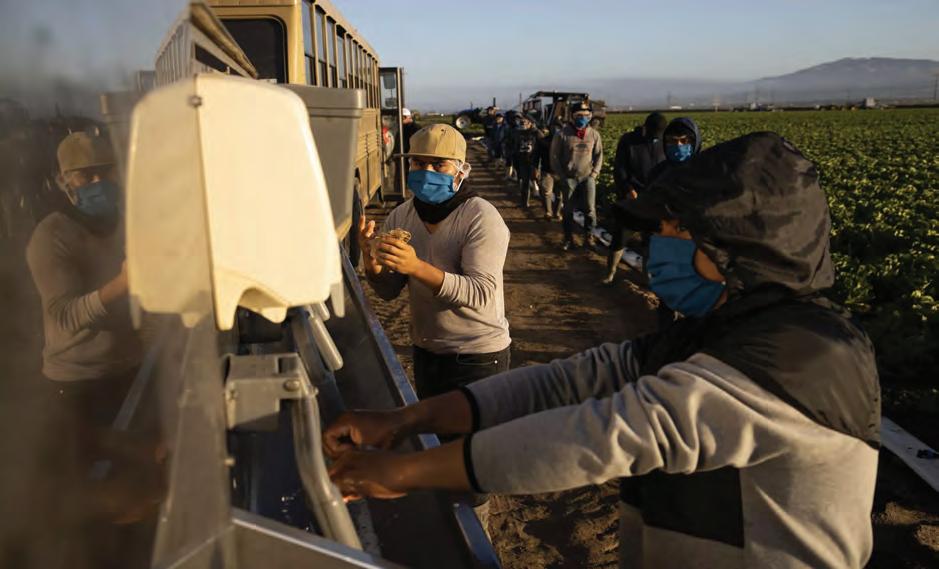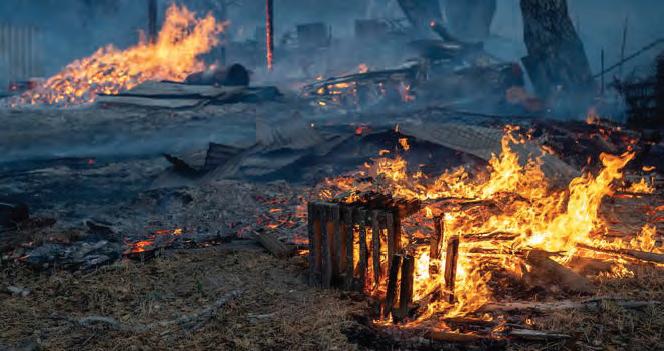
6 minute read
Toiling in the Smoke: Historic Wildfires Threaten California’s Agricultural Workforce
Toiling in the Smoke:
By Teresa Campbell
Advertisement
Redwood tree burning after CZU August Lightning Complex passed through (Kent Nishimura / Los Angeles Times)
“The sky darkened… It was like night during the day.” This could be the opening line to a sci-fi movie, yet it was a farmworker’s description of a California vineyard in mid-September.
As fires ravaged close by, he continued to pick grapes, working through the smoke dense enough to blot out the sun. It seemed apocalyptic, and all the while, the farmworkers returned to harvest.
Across California, checking the air quality becomes a routine for many in the fall. Changing plans based on the forecasted AQI becomes a seasonal affair.
However, many people do not share the choice of minimizing their exposure. Hazardous air quality caused by California wildfires is forcing farmworkers to choose between their health or their income. Many choose the latter, as economic needs take priority over future health repercussions.
Environmental justice and human rights activists are calling on the state and federal government to address the disproportionate effect of wildfires on California’s agricultural communities by creating economic safety nets to protect their health and livelihood.
As of January 2021, California wildfires have already decimated an estimated 4.1 million acres of land. According to Cal Fire, climate change has created hotter temperatures through the spring and summer and has shortened periods of snow, which creates longer dry seasons that increase the risk of wildfires. The number of extreme fire risk days has doubled since 1980.
This weather intensification is threatening the already short windows that characterize California's harvest seasons. Some types of produce only have a two-week harvest window, driving farm labor during even the worst environmental conditions.
This has large repercussions for farmworkers in California, widely considered an agricultural epicenter in the nation. In 2019, over $50 billion dollars was generated by the agricultural sector, over 400 commodities produced in California were shipped worldwide, and hundreds of thousands of
One farmworker I spoke with, who asked to remain anonymous over concern for his job, continued working the vineyards in Monterey County even as smoke darkened the sky.
“It was really bad when the fires were at their worst,” said the worker. He, who I will refer to as G., is 38 years old and has worked in agriculture for 18 years. G. works at the vineyard five days a week from 7 a.m. to 5 p.m. On the sixth day, G. does landscaping.
During fire seasons, G. comes home with chronic headaches, dizziness, and shortness of breath: all common repercussions of exposure to unhealthy air quality. Long-term risks include asthma and scarred lungs, but these are not issues many farmworkers can afford to think about.
Still, the consequences of wildfires go beyond physical health. G. described the panic that arose from being forced to breathe in smoke all day.
“I didn’t want to be breathing that air,” he said. “I wanted to go home. It just didn’t feel like where I should be.” However, despite his mounting anxiety, G. faced 10 hours of work a day, as going home meant risking his job and income.
To compound this struggle, G. said that the farm owners did not supply N-95 masks to the workers or have a conversation with them regarding their rights or protections. Cal/OSHA, California’s Division of Occupational Safety and Health, requires employers to supply N-95 masks to workers when the air is over 150 AQI. In Monterey County, the AQI hovered around 200 in mid-September.
Frustrated that the farm owners were neglecting to acknowledge the horrific conditions that workers were facing, G. and several of his colleagues took it upon themselves to find their own N-95 masks. However, the masks were out of stock in every local store. Ultimately, the workers were left to work all day without protection to feed a country that they felt was not caring for them.
When asked why he avoids speaking to the farm owner about protections, G. said that he wants to, but fears losing his job. The inability to speak up against injustice is a pervasive issue in the farmworker community. Many people cannot risk losing a day’s income by missing work on a day with hazardous air quality, or worse, being fired for speaking up.
COVID-19 has exacerbated this fear, according to Dr. Don Villarejo, co-founder and executive director emeritus of the California Institute for Rural Studies. Due to the pandemic and the ensuing economic crisis, over $8 billion in grower revenue will be lost during the current calendar year, which is about 20% of the revenue California growers were predicted to make in 2020. This loss of

Farm laborers in masks wash their hands before work in Greenfield, California (Brent Stirton/Getty Images)

revenue often translates to layoffs, a looming threat to workers.
In addition, undocumented workers, who make up an estimated 50% of the farmworker population in California, were hit disproportionately hard by the COVID-19 pandemic. Undocumented workers are not eligible for food stamps, unemployment insurance or a variety of federal financial support programs, including the federal stimulus payments.
Villarejo described the inequality between documented and undocumented workers as tragic: “It means that essential workers… are denied the same benefits as even the people with whom they work.”
Yet, while it is difficult for workers like G. to hold farm owners accountable, the burden should not fall on to them to do so in the first place.
A policy transformation needs to go beyond the requirement of distributing N-95 masks, said Alexis Guild, director of Health Policy and Programs at Farmworker Justice. Guild explained that there are ways to improve ventilation in the fields, such as fans and other air quality control technologies that farmers can invest in. Additionally, better wages, a path to citizenship, overtime protection, more comprehensive labor laws, and increased access to education are among many

It is worth noting that there are farms, like Swanton Berry Farm, that are dedicated to protecting farmworkers. Their website states that “the dignity of farm labor is a founding principle of Swanton Berry Farm.” The website further elaborates how the farm has worked to honor the mental and physical health of their coworkers by implementing medical plans, retirement plans, paid vacation time, and hourly pay rather than a piece rate. These working conditions are important steps forward in the continuous process of ensuring farmworker justice.
Villajero believes that there are two ways that those concerned can support farmworker empowerment: one is by voting, and another is by organizing. In his eyes, voting for representatives who will prioritize farmworker communities is critical in creating effective and comprehensive policy.
“[Organizing] can be life changing, and it can be rewarding [for both those organizing and those benefiting from it],” said Villarejo. Below is a list of organizations partnered with the COVID-19 Farmworker Study (COFS) that Villajero recommends people to engage with or explore internship opportunities.
When I asked G. what he would like to share with students, he said, “I would like if everyone would take us more into account, because we work hard, and we should be given protection.”
G.’s statement points to an obligation and privilege that people have to support and uplift those who are the very backbone of our society’s health and national economy.
“A lot of pride and dignity in farmwork gets left out of conversation which is important to share; share not just about challenges but also dignity,” said Guild. She believes that farmworkers need to be present in our daily conversations and receive our gratitude.
According to Guild: we need to talk about farmworkers, honor them, and then work to show that appreciation tangibly through being an activist for their rights.
Organizations partnered with COFS: Centro Binacional para el Desarrollo Indígena Oaxaqueño, Central California Environmental Justice Network, Lideres Campesinas, Alianza Ecologista, Comité Civico del Valle, The Farm Worker Care Coalition, California Institute For Rural Studies, Community Alliance with Family Farmers, Alianza Nacional de Campesinas, and The Western Center for Ag Worker Health and Safety











